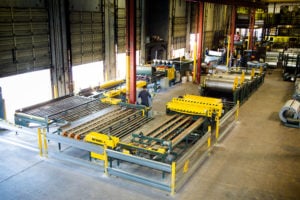Many companies say they like to think of their customers as “partners” and avoid using terms that denote the conventional vendor-client relationship.
But when you look past the talk, it sounds pretty much like every other commercial interaction: somebody is (hopefully) buying what someone else is selling.
But that’s not the way officials with Zinger Sheet Metal Co. Inc. say they conduct business. The third generation, family-owned duct fabrication company has tripled revenues during the last 13 years, thanks in part, they say, to a philosophy that eschews the take-it-or-leave attitude especially prevalent in a busy construction market.
“I think first and foremost who we are is a partner for our customers,” says David Capestany, the current owner and grandson of Henry Zinger, who co-founded the sheet metal firm in 1954. “We try to figure out what works for our customers.”
The goal, he says, is to deliver each order in a way that ensures Zinger will earn the next one. It’s a business model that seems to be working. From $1.2 million in revenue in 2005, today Zinger grosses an estimated $3.5 million making ductwork and HVAC components out of its 20,000-square-foot facility in Grand Rapids, Michigan. High-profile projects Zinger has been involved in include power plants, condominiums, hospitals, and churches.
Another way that Zinger ensures customers stay satisfied is by keeping its sheet metal shop full of up-to-date equipment. Recently, the company decided it might need to replace its existing coil line.
“We had a coil line that was aging,” Capestany says. It lacked the options available on the newest equipment, such as tie rod punching, and it could not automatically install duct liner.
“It was older technology and an older design, so we had a lot of issues with ductwork that might come out twisting,” he says. “We’ve always tried to have the latest and greatest equipment.”
The company decided to invest in a new coil line. They looked at the options and decided on a unit from Mestek Machinery. Capestany said he liked that the Mestek unit had a machine-based controller instead of a PC-based one.

An example of what a coil line like Zinger’s could look like once in a shop
Another plus was the Mestek unit could handle the large duct that a lot of customers are preferring, Capestany said. The Mestek machine could handle 60-inch-wide steel coils. On Zinger’s former coil line, employees used to have to fabricate duct in L sections or as flat duct if customers wanted liner installed. And the liner had to be added by hand. With the new machine, liner can be put on automatically.
“If the need called, we could put out 10,000 pounds of lined ductwork, either with half-inch lined or 1-inch Armaflex,” Capestany says, “We can do all that in a day.”
Zinger also recently purchased a Roto-Die press brake and another spiral duct machine from Mestek for its shop.
“By adding an additional spiral line, now we can have one set up to handle our galvanized all day, every day,” Capestany says. “And we also have an additional machine so when needed, we can output twice as much spiral duct at one time,”
Capestany says he’s very happy with the new equipment. And his employees are too since it makes them more efficient.
“Mestek was able to solve the problems that we had,” he says. “They were able to make a machine that was really customizable to us and what we needed.”

